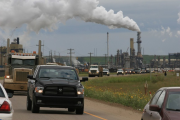With another round of rallies against the proposed Keystone XL pipeline planned for this weekend — and in the face of a clear commitment to tackling climate change in President Obama’s second term — Canada’s environmental record is coming under fresh scrutiny in the U.S.
The government’s answer to its U.S. critics? We’re not so different, you and I.
Foreign Affairs Minister John Baird responded to questions about pipelines at a recent press conference with U.S. Secretary of State John Kerry by saying that “when it comes to the environment, I think we have likeminded objectives.”
Natural Resources Minister Joe Oliver gave the same message to those who “want to be reassured that we’re not cavalier about the environment,” asserting that “we’re moving in lockstep with the United States on a number of critical issues.”
Unfortunately, it’s not that simple.
Same target, different trajectories
Canada and the U.S. do have the same greenhouse gas reduction target for 2020, because Canada adopted the U.S. target back in 2010.
Hitting that target (a 17 per cent reduction below the 2005 emission level) won’t be easy for either country. But the goal is in sight for the U.S., according to a pair of recent papers from respected American think tanks.
A 2012 analysis from Resources for the Future found that the U.S. is essentially on track to hit its target, provided that the government continues with its current regulatory effort.
And a paper published this month by the World Resources Institute concludes that more effort is needed, but that the U.S. can hit the target if the Obama administration makes high-ambition policy choices using existing legislation.
This week’s State of the Union address signalled that the President is headed in exactly that direction: he said that the United States must do more to combat climate change, and “if Congress won’t act soon to protect future generations, I will.”
In contrast, no one believes that Canada is close to hitting its 2020 target. The federal environment commissioner said in 2012 that we’re running out of time to get the policies we need into place. The now-defunct National Round Table on the Environment and the Economy also concluded last year that Canada is not on track to hit the target, adding that this won’t change “unless significant new, additional measures are taken. More will have to be done.”
Environment Canada’s own projections are equally gloomy. The most recent analysis showing that we’re on track to close only half the gap to the target, meaning that Canada would miss its 2020 goal by over one hundred million tonnes even after factoring in the effects of all existing federal and provincial policies.
Canada did follow the U.S. in adopting fuel efficiency standards for vehicles, and the standards will make a difference in both countries over time.
Both federal governments have set performance standards for new coal plants, and Canada has also adopted rules that kick in once coal plants are half a century old. Neither federal government has yet set standards for emissions from existing coal-fired electricity plants (the years before the end of a plant’s “lifetime”) — although many expect Environmental Protection Agency regulations on existing coal plants to be among President Obama’s next moves in tackling climate change.
Both countries also benefit from some climate action at the sub-national level, from their states and provinces.
So why does the U.S. have fair prospects for a passing grade while Canada is on track to flunk its 2020 climate exam?
More than anything else, the difference comes down to the oilsands.
Environment Canada’s analysis finds that, from 2005 to 2020, the projected growth in greenhouse gas pollution from the oilsands is so large that it will cancel out all the reductions that other parts of the economy are expected to make over that same time period.
Despite the oilsands' outsized role in Canada’s emissions picture, there are still zero federal constraints on greenhouse gas pollution from the sector.
The government has been at the table with oil and gas companies negotiating greenhouse gas regulations for years now. Meanwhile, oilsands emissions continue to grow, increasing by 50 per cent over the five years between 2005 and 2010 alone.
The U.S. doesn’t really have an oilsands sector, which means that harmonizing with the U.S. won’t solve Canada’s biggest climate change problem. Of course, the oilsands is also the sector that opponents of the Keystone pipeline have zeroed in on, and with good reason.
But it’s not the only difference between the two countries.
A growing gap
Financial support for clean energy has been a consistent priority of the Obama Administration. In Canada, the federal government has ended its support for new renewable energy production and for residential energy efficiency improvements.
While President Obama supported carbon pricing policies that failed to pass the U.S. Senate, Stephen Harper’s government rarely misses a chance to condemn carbon pricing. And a majority government in Canada doesn’t have to contend with the checks and balances (and filibuster rules) that President Obama faces: if Prime Minister Harper wanted to put a strong climate policy package in place, he could do so tomorrow.
It’s fair to question Canada’s seriousness when we say we’ll finish a marathon but never quite manage to get out the door for a training run.
To show the U.S. that we really do have “likeminded objectives,” we need a serious plan to hit our 2020 target. That could certainly involve taking action in partnership with the U.S. where it makes sense, but it’s also going to require a uniquely Canadian response to our specific circumstances — most notably our oil and gas sector.
As former Environment Minister Jim Prentice put it in a recent speech (albeit in a different context), we must not be “lulled into believing” that U.S. and Canadian interests on energy “will ever be identical.”
Frankly, outsourcing climate and energy policy to another country probably isn’t a good idea for anyone. It’s certainly not a responsible plan for Canada, a country that ranks among the world’s top 10 greenhouse gas polluters.
That’s the bigger picture. For this week, the bottom line is that a claim that we’re “in lockstep” the U.S. simply doesn’t provide a convincing response to Keystone XL’s many critics. Only a lot more meat on the bones of Canada’s climate plans could do that.






